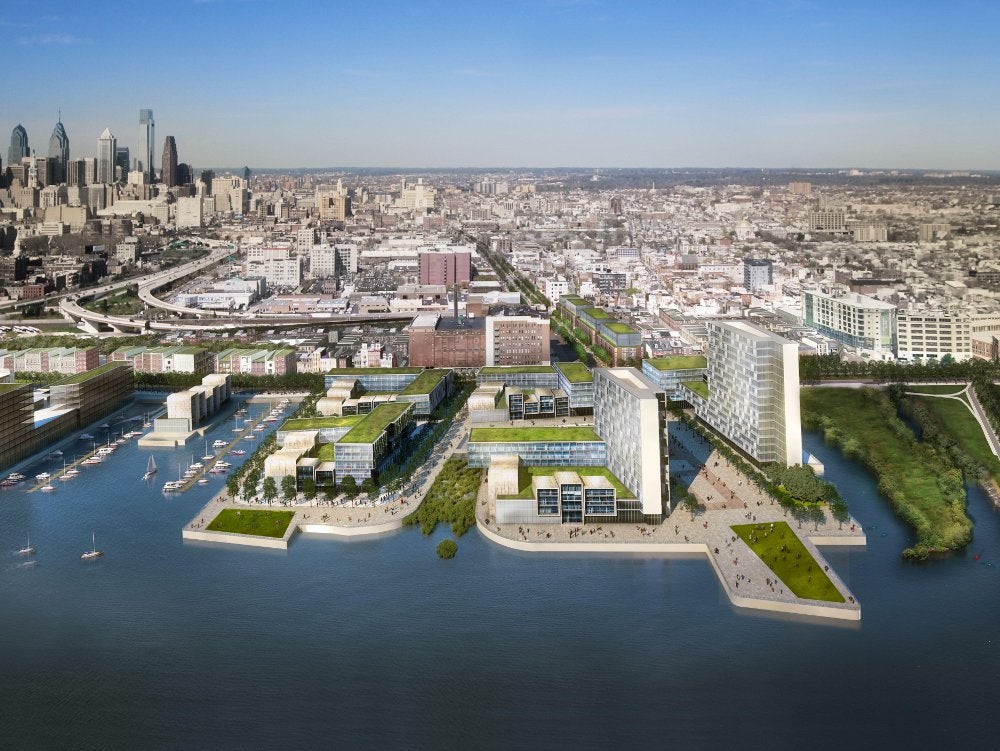Long-term blueprint for the Central Delaware Waterfront adopted, heading to planning commission

The Master Plan for the Central Delaware Waterfront – the long-range blue print the city hopes will pave the way toward a revitalized riverfront – was today unanimously approved by the Delaware River Waterfront Corporation board.
The city asked the DRWC to develop the master plan as the guide for the revitalization of the Central Delaware River waterfront, from Oregon to Allegheny avenues, for decades to come. The city believes that revitalizing the waterfront will spur growth and development along the water and into the neighborhoods beyond it. The plan came together after years of public input sessions and smaller meetings with residents, land owners, and other key stakeholders, said development chair Marilyn Jordan Taylor, who is also the dean of Penn’s School of Design.
Plan principles include extending the city street grid to the waterfront to reconnect the city and the river; creating or maintaining open space every half mile and linking those park areas with a multi-purpose, waterfront trail; developing public property with mixed-use development, including residential, commercial, recreational and entertainment; and using the public space development as a lure to encourage private development. Read the plan here. While the plan isn’t official yet, some “early action items” have been tackled on publically owned land already, including the new Race Street Pier park, Washington Avenue Green, and the Race Street Connector.
“It really is the culmination of two-and-a-half years, and a whole lot of work by a whole lot of people,” said DRWC President Tom Corcoran after the meeting. “We hope the Planning Commission adopts it as proposed.” The Planning Commission, which seemed largely pleased at an information-only presentation on the plan in August, is expected to vote on adoption at its November meeting.
Several leaders from waterfront civic groups – all of whom also represent their groups on the Central Delaware Advocacy Group, the board that advocates for the public’s wishes for the master plan – praised the plan and the process that created it.
“You pretty much completely nailed it,” said Queen Village Civic President Jeff Rush.
CDAG Secretary Joe Schiavo – who is also an Old City Civic board member – praised DRWC for being accessible when community members had concerns or questions. New Kensington Community Development Corporation Executive Director Sandy Salzman asked that both DRWC and developers “remember the community” and talk to the community as the plan moves forward.
But representatives of James Anderson and the partners with whom he owns four waterfront parcels asked DRWC to exempt their 57.25 acres from the plan, which they said would hinder their clients’ ability to develop their privately owned land as they wish.
DRWC development committee chair Marilyn Jordan Taylor gives a history of the plan. Property owner representative Craig Schelter outlines the property owners’ concerns and asks that 57 acres be exempted. Civic leaders from waterfront neighborhoods praise the plan and urge the board to go forward.
Craig Schelter, executive director of the Development Workshop and a former executive director of the city planning commission, said the land owners applaud the parts of the master plan that focus on public property improvements, but remain concerned that the call for a public trail, street extension and parkland throughout the entire waterfront amounts to a taking of their property without compensation. Schelter presented the board with an analysis done for the landowners by Kennedy & Associates that concludes 34 acres would remain available for development if all the components of the plan were applied to the parcels. (The board and many in the public refer to these parcels as The Anderson Property, but Kevin Feeley, a spokesman for the landowners, said since there is more than one owner, they call the land the Cramp Shipyard properties, after the now-defunct shipbuilder.)
“The biggest concern that we have is that what we see in the master plan is that there will be recommendations talking about using the zoning code on these properties where development will not take place for 20 to 25 years, using the zoning power to acquire public use of the land,” Schelter said. “That’s something we believe to be illegal.”
See a map with the study findings here. Read letters that Schelter wrote to DRWC detailing these concerns here and here.
The land owners’ attorney, Herbert Bass, expounded on this after the meeting, saying that “when someone goes in for a permit to build or develop, the city will say the have to agree (to the street extension, walking trail and other public uses) in order to get the permit.” Read a letter Bass wrote about legal issues here.
Not so, said Corcoran. “Using a zoning permit to extract a donation of land, or a taking of land, is not something that we believe is constitutional,” he said.
DRWC Director of Planning Sarah Thorp said it was never the intent of the draft document to imply that, but “we do thank Mr. Schelter and Mr. Anderson for bringing to our attention ambiguous language.”
Corcoran said new language added on page 37 makes this “unequivocal.” The language he referred to reads: “Ninety percent of the project area is in private ownership … Land and/or easements must be acquired in order to implement the master plan. Even if adopted by the Planning Commission, the master plan does not have the legal effect of a zoning ordinance. Nonetheless, DRWC is committed to advocating for the acquisition of property in conformity with applicable law.”
According to the resolution passed by DRWC, the plan goes into effect when the city’s new zoning code goes into effect. The new code is before city council, but the document does not contain zoning law related to the master plan.
Zoning Code Commission Executive Director Eva Gladstone will be working on a new Central Delaware zoning overlay over the next six months, Thorp said. Until then, the current overlay stands. DRWC Board Member Alan Greenberger, who is also the city’s deputy mayor for planning and economic development, said the new code would likely take effect in September 2012.
Old or new, no zoning can require a private landowner to allow public egress on a waterfront trail, Thorp said. But zoning can require a building set back. If a developers pulled a permit under the current overlay, they would have to build 100 feet away from the water, she said. The new overlay will call for 50 feet, she said. Thorp said this is not a taking, and setbacks are required elsewhere in the city.
The platting of streets is another city process, separate from zoning, Corcoran said. The city has the right to build new streets, she said, and it would not take the land to do so, but would negotiate an agreement with property owners that could, for example, include purchasing land or allowing the property owner to build more densely on remaining land, she said.
Corcoran and Thorp speak to the land owner representatives’ concerns. Thorp also talks about changes and clarifications made since the draft version.
Schelter was the first to speak during the master plan public comment session, and the civic leaders who spoke after him took issue with the land owners’ position.
Anderson has a paving business, and he has items related to that business on his property. The land is also being environmentally remediated, representatives said, and it is not vacant, as is the common perception.
Northern Liberties Neighbors Association President Matt Ruben didn’t hear those comments, but he did essentially call Anderson a land banker. “Twenty years of banking vacant land doesn’t lead to an indefinite ability to have vacant land banking just so you can continue to try to find a buyer that may or not be out there,” he said.
“Do not be bullied, because that is what the attempt is here,” he told the board. “We are all behind you.”
When asked what the Anderson/Cramp property owners would do now that their request was denied by the DRWC, spokesman Feeley said they are “in the process of reviewing all of their options.”
“The next step is to prepare for the Planning Commission and hope they take our comments more seriously than the DRWC did,”
Schelter said.
Corcoran said DRWC will be focusing its efforts on completing projects the plan calls for, including the development of the multi-purpose trail and the re-purposing of Pier 9, which is now largely used as a garage.
Reach the reporter at kgates@planphilly.com
WHYY is your source for fact-based, in-depth journalism and information. As a nonprofit organization, we rely on financial support from readers like you. Please give today.



